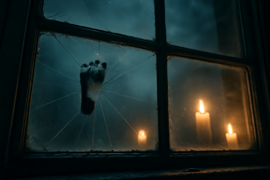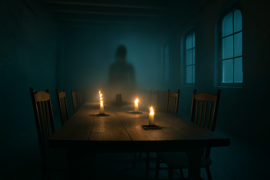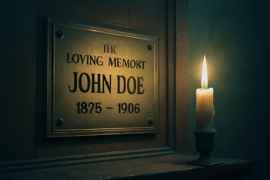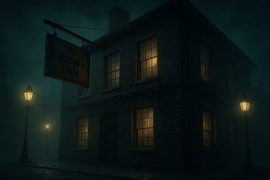Introduction
On the edge of Maple Street, where evening shadows linger longer than they should, stands the venerable facade of Klea Pete Restaurant. Its red-brick walls and stained-glass windows hint at stories carried in its mortar, tales of merchants and travelers whispered through generations. By day, warm lamplight filters across oak shelves once laden with dry goods, now holding rows of menus and vintage bottles of root beer. But as dusk settles, a different atmosphere emerges. The creak of ancient floorboards, the faint rustle of curtains in the breeze, and a chill that seems to rise from the cellar floor draw patrons into an encounter with the past. Locals exchange cautious glances when ordering their evening coffee, recalling old legends that speak of a boy—no older than ten—who in life owned the innocence of youth and in death the restlessness of the unsettled.
At the heart of the restaurant, the original tin ceiling arches overhead, its pressed patterns casting shadows that dance in the flicker of antique chandeliers. Walls once painted in muted mustard have faded to a patina that glows in the lamplight. The air carries notes of aged oak, homemade pies, and something else—a faint perfume of lavender and damp earth that drifts through walls. When the clock strikes nine, the atmosphere shifts. Chairs scrape by themselves. A door rattles on its hinge. Glasses clink without cause. Servers exchange nervous smiles, wary of what land unseen feet might tread. In a corner booth that only opens on cold nights, a small figure may be glimpsed, humming an old folk tune half-forgotten by time. Tonight, you step inside and listen to the echoes. The story of Klea Pete’s ghostly child begins here, where reality and legend overlap.
Origins of the Ghost Legend
Klea Pete Restaurant began life in 1874 as a modest dry goods store owned by Peter Klea, a widower who moved west to start anew with his only son, Samuel. The pair set to work unpacking burlap sacks of flour and barrels of molasses, transforming dusty crates into carefully arranged displays. Peter’s shop became a community gathering place; farmers bartered produce for fabric, housewives debated recipes, and children lingered by the candy jars. Young Samuel was known for his bright laugh and adventurous spirit. He would race among the shelves, chasing stray kittens and offering sweets to customers with wide-eyed delight. In those early days, the building’s backroom held just enough space for a small desk where Peter balanced ledgers by candlelight while Samuel pressed silver dollars into curious hands.

But one winter evening, tragedy struck. A misstep on the frost-coated stoop sent Samuel tumbling into the icy street below. Despite his father’s desperate efforts and the neighborhood doctor’s ministrations, Samuel succumbed to his injuries at dawn. The town mourned the boy who had charmed every heart, and Peter’s grief closed the business for months. When he finally reopened, locals claimed the shelves still teemed with strange footprints, and candles flickered even without wind. Rumors spread that Samuel’s spirit lingered among the crates he once loved.
Over the decades, the store changed hands several times, but the legend endured. During Prohibition, the building fell silent; whispers say a ghostly knock would echo at midnight, invisible hands rattling locked doors. When the doors opened again in 1932 as a small neighborhood café, the owner claimed a boyish giggle fluttered through the dining room, leading to a sudden chill at table seventeen. Patrons told of a child’s face glimpsed in reflection, always behind them, watching.
In 1978, during a heavy windstorm, a chandelier crashed to the floor while the restaurant was empty. Investigators found no structural damage that could explain the fall. The only clue was a single, muddy footprint on a shattered pane of stained glass, shaped like a small boot no child of this century ever wore. The community buzzed with speculation, and journalists flocked to Maple Street to photograph the so-called "ghost window." The image appeared in newspapers nationwide under headlines like "Boy Ghost Haunts Old Store."
As generations passed, the tale of Samuel Klea grew into an enduring legend. It is said that on the frostiest nights he returns, searching for the warmth and laughter stolen from him so long ago. Servers recall dropping trays for no reason, chairs sliding away from empty booths, and soft footsteps weaving between tables. Whether skeptical or devout, anyone who spends a winter evening at Klea Pete Restaurant feels the weight of history pressing close, a presence unseen yet profoundly felt.
Encounters After Dark
Many who have worked behind the counter or seated guests in shadowed corners share stories that blur the line between skepticism and belief. Emma, a server of ten years, recalls one winter evening when she delivered a pot of coffee to booth eight and heard a soft whisper in her ear. It wasn’t a voice she recognized; it belonged to a child but carried an otherworldly echo. She froze, convinced someone stood behind her, only to find empty air. The steam from the coffee swirled, revealing faint shapes in the chill—shapes she swore resembled small hands pressing against the glass.

Another longtime bartender, Marco, swears he saw a boy dart across the dining room, laughing, as a tray of glasses tilted and spilled in perfect rhythmic pattern. The glasses fell one by one, always on the last beat of a silent tune. Patrons gasped, servers rushed to clean up, but no one could explain how trays slid from stable hands all at once. Marco says he looked up afterward and glimpsed a small face peeking from behind a pillar before slipping away into the gloom.
On nights of back-to-back reservations, the old ledger behind the bar sometimes turns open to a blank page by itself. Manager Carolyn found it once with smudged pencil marks indicating “Samuel’s Table” at half past eleven—though she had never written it herself. Equipment malfunctions follow close behind: lights strobe, the sound system crackles, and sometimes the doors lock of their own accord. Guests eager for dinner find themselves locked in until someone finally decides to leave; the doors then swing freely, as if released by an unseen hand.
Local paranormal investigators have set up cameras in empty dining areas. Their footage captures translucent shapes drifting past windows and unexplained orbs of light gliding along the floor near the cellar door. In one grainy clip, a small figure opens a drawer behind the register and closes it with deliberate care. Though the building’s current owners dismiss such activity as quirks of old construction, the evidence piles up too persistently to ignore.
Travel bloggers and ghost tour guides now include Klea Pete Restaurant on their circuit. Visitors arrive with cameras, EMF meters, and skeptical smiles, only to leave shaken. Some report hearing children’s laughter drifting down the alley as they exit; others mention feeling a tug on their jackets, as if the boy still hopes for company. On the coldest nights, servers light extra candles and smooth the table linens twice, hoping to appease the restless spirit. Patrons order extra hot chocolate and gingerbread in tribute, and at midnight a hush falls, prompting many to raise their candles and murmur a silent goodnight to Samuel.
Unraveling the Truth
Over time, a handful of determined locals set out to uncover the factual roots beneath the legend. Historical society volunteer Maria Lindgren spent months combing through old town records, tax ledgers, and newspaper archives. She discovered that after Samuel’s tragic accident, Peter Klea disappeared from public life, eventually moving away and selling the property. The building served various purposes—a tailor’s shop, a dry cleaner, a speakeasy—each owner reporting odd occurrences, though few publicized them.

Maria located Peter Klea’s diary, bound in cracked leather and hidden behind a false panel above the attic stairs. Its pages, written in a delicate, looping hand, document his grief and the daily life of the little store. The final entries described shadowy footprints in the dust, soft lullabies wafting from empty rooms, and the overwhelming desire Peter felt to open the door for a visitor that never came. One last entry simply read: "Samuel waits by the shelf I built him, child of my heart, won’t you come home?"
Armed with this personal account, Maria organized an evening gathering at the restaurant. She invited skeptics, believers, historians, and members of the Klea family, now scattered across the country. Inside the original backroom—restored with warm wood panels and framed excerpts from Peter’s diary—they lit candles around Samuel’s favorite shelf, where his small wooden toy horse once perched. As the candles flickered, the room grew cold. Witnesses say they saw a child’s silhouette materialize near the shelf, bowing his head before vanishing. A gentle tapping came from the wall behind them, like the soft thump of a small foot.
After that night, the restaurant installed a small memorial plaque: "In Memory of Samuel Klea, 1865–1874. May no child remain lonely." Since then, reports of terrifying bumps and disembodied laughter have largely softened. Patrons still feel unseen breezes and hear faint humming, but many say the atmosphere has grown kinder. Servers near the plaque feel a gentle warmth, and some leave small toys or cookies by the shelf as an offering.
The truth behind the haunting is woven of sorrow, love, and the simple hope of a child seeking connection. Whether you arrive as a skeptic or believer, a visit to Klea Pete Restaurant invites you to acknowledge a presence that refuses to fade. In the quiet moments between courses, listen for a soft giggle or the tap of little shoes—Samual Klea’s spirit still wanders, not to frighten, but to be remembered.
Conclusion
The legend of Klea Pete Restaurant stands as a testament to the power of memory and the bond between a father and his son. For nearly a century and a half, the building has borne witness to life’s most ordinary moments—shopping for flour, sharing a meal, laughing over a pint—and life’s most extraordinary sorrow. Samuel’s story reminds us that the boundaries between past and present can blur in the quiet hours, when candlelight stretches shadows across wooden floors and the hush of night invites forgotten voices to speak. Though some still question the reality of his presence, those who have set foot inside the old dry goods store know that Samuel’s spirit lingers in every nook and corridor, a gentle reminder that love endures beyond the veil of time. Whether you come to dine or to chase a ghost story, you leave having touched something beyond the ordinary: the echo of a child’s laughter woven into the walls themselves, urging you to remember a life cut short but never forgotten. Tonight, when you think you’re alone in the dark, pause and listen. You just might hear him ask, ever so softly, for one more friend to share his table and keep his memory alive.

















